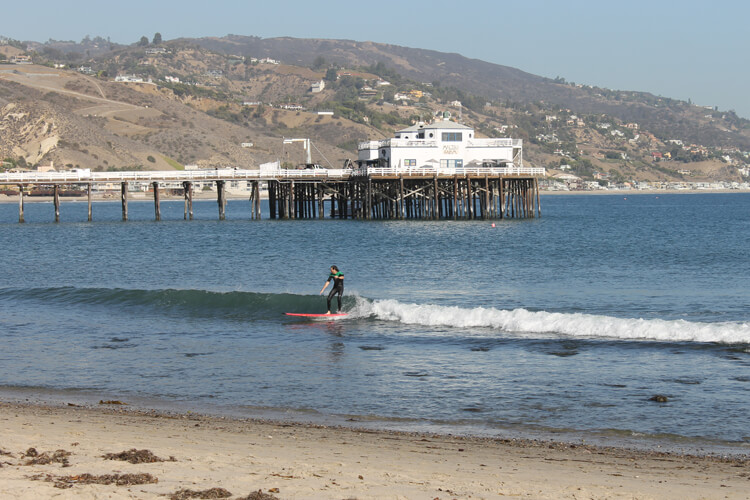Malibu Surfrider Beach is one of the epicenters of surfing in California and probably the most famous surf break in mainland America.
The legendary point break became a popular surf spot in the 1950s and 1960s with the rise of surfing as an all-year-round outdoor sport.
Surfrider Beach also played a critical role in the development of the sport over the decades. It's a charismatic place with as many stories as the number of people who enjoyed it along the way.
The first surfers to ride a wave at Malibu were Tom Blake and his friend Sam Reid in 1927.
During World War II, Malibu was already the go-to surf spot for California wave riders. Today, it's a popular surf destination for both retro and longboard enthusiasts, new school, and even tandem surfers.
Surfrider Beach is located 30 miles west of Los Angeles in the Malibu Lagoon, where Malibu Creek meets the Pacific Ocean.
The south-facing cobblestone spot can be found halfway between the Malibu Lagoon and the Malibu Pier.
Surfrider Beach is also identified as Malibu Lagoon State Beach and offers three main peaks, sections, or take-off zones:
- First Point;
- Second Point;
- Third Point;
Surfrider Beach was one of Miki Dora's favorite surf breaks, and it's a place where one can still witness today the black knight of surfing's influence.
It was also the testing site for the Malibu Chip.
The famous 10' balsa-core board incorporated both the old Hawaiian design and the new California wave riding needs.
Legends like Bob Simmons, Lance Carson, Mickey Munoz, Miike Doyle, Matt Kivlin, Joe Quigg, Kemp Aaberg, Dewey Weber, Johhny Fain, Terry "Tubesteak" Tracy, and Dora rode the Malibu Chip.
They helped change noseriding forever with this 22-inch wide board. Australians still refer to longboards as "mals," a short for the Malibu board.
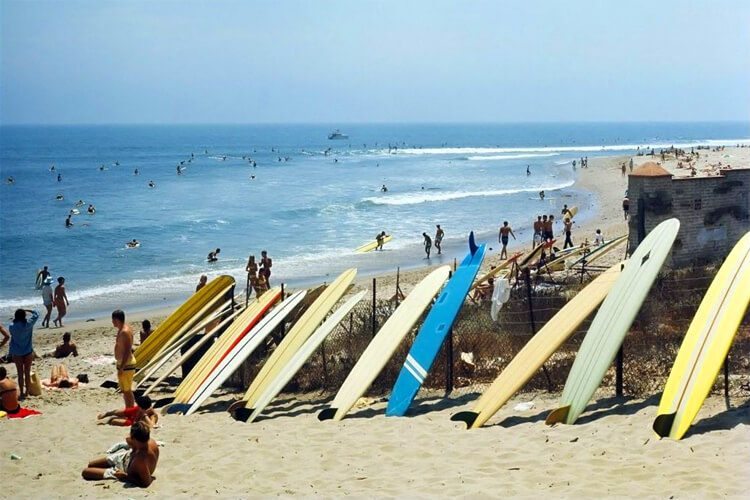
A Timeless Point Break
As journalist Paull Grass once put it, "Malibu is the exact spot on Earth where ancient surfing became modern surfing."
Some say Malibu's Surfrider Beach is the seedbed of modern surf culture; others will tell you that it epitomizes the heart and soul of surfing.
The fact is that the point break changed a lot in less than a century.
"People will tell you that today the 'Bu' is a nightmare," wrote Michael Fordham, the author of "The Book of Surfing."
"They will tell you that the crowds have destroyed the sacred ambiance of the place that the native Chumash named 'surf sounds loudly.'"
Malibu is actually the English version of the Chumash Indian word "Hamaliwu," meaning "surf sounds loudly."
"But ignore them. Despite the pollution, the drop-ins, the funked-up crowd of wave riders, catching a peeler from Malibu's First Point and trimming towards the pier is to step through the door into timeless tradition," continues Fordham.
"Just one wave is worth the airfare."
Over the decades, Malibu became home to Hollywood movie stars and studio producers and even inspired the creation of the blockbuster "Gidget."
In the early 1960s, Malibu got so crowded that you could easily count over 100 surfers in the lineup on an average day.
The Malibu Surfing Association, one of California's first surf clubs, was founded in 1962 to defend and protect the iconic surf break.
Seven years later, Malibu Lagoon suffered one of the first major environmental disasters caused by runoff, sewage, and waste.
But the ongoing environmental issues in Malibu were becoming so frequent that they eventually led to the creation of the Surfrider Foundation in 1984.
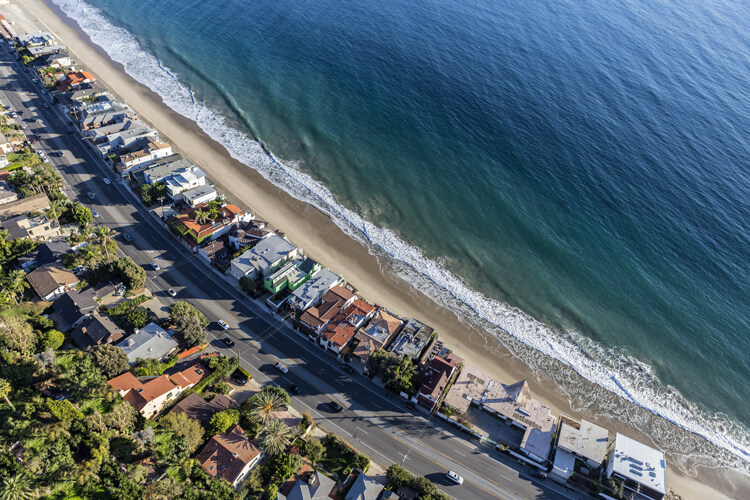
Dream Rides
Yes, it's often crowded. And yes, it's hard to get a good wave.
But if you're patient and wait for your turn, you might ride a wave that you'll remember forever.
The classic summertime cobblestone point break is the ultimate California longboarding wave - a hotdogging paradise.
On a glassy evening session, you may be lucky to experience a 300-yard ride on a tapering, smooth-breaking wave with the Pacific Coast Highway running by your side.
Some say it's the best longboard wave in the world.
The best timeless description of Malibu's three main peaks was made by David H. Stern and William S. Cleary, authors of the 1963 classic book "Surfing Guide to Southern California."
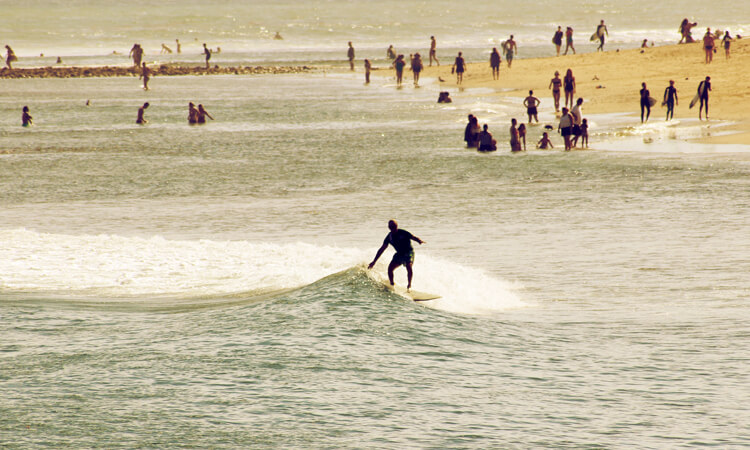
First Point
Hailed as California's best right-hand point wave, First Point is the ultimate inside wave and the most consistent Malibu peak.
It's a long, lazy, and evenly breaking wave perfect for hanging ten displays that could very well end across the pier.
"When surfers say 'Malibu,' they often mean the First Point, where waves build into an amazingly well-shaped right wall which offers maximum in turning and noseriding for 300 yards or more," explained Stern and Cleary in their book.
"A few strong west swells produce small waves here, while north swells produce absolutely nothing."
"Waves are not always tubular but seldom mushy except at very high tides. The slightest south wind completely destroys wave quality, but normal afternoon west sea breeze comes from slightly offshore, so the area seldom blows out."
"Small rocks begin below mean high tide line and are more numerous and sharper toward the point, where spiny sea-urchins also abound."
"The classic take-off spot is at the point in line with two of the three flagpoles in front of Rindge Mansion."
"Chief cause of arguments, accidents, and general brouhaha is the large number of people who sit farther inside and paddle into waves ahead of surfers who are already riding and thus have the right of way."
"However, there is room for a few surfers to sit inside and take advantage of waves missed or goofed by those at the point."
"Even then, more than about 20 surfers make the water seem crowded. Usual summer crowd in the water: 40-100."
Second Point
The Second Point offers a larger, faster, and less predictable wave that might close out or connect to First Point.
"Waves bigger and hollower than at First Point offer faster (frequently unmakable) but shorter rights," added David H. Stern and William. S. Cleary.
"However, freak rides from here to the pier have been reported. Best at medium/high incoming tide. West wind blows out the surf."
Second Point is more susceptible to subtle changes in tide and swell direction.
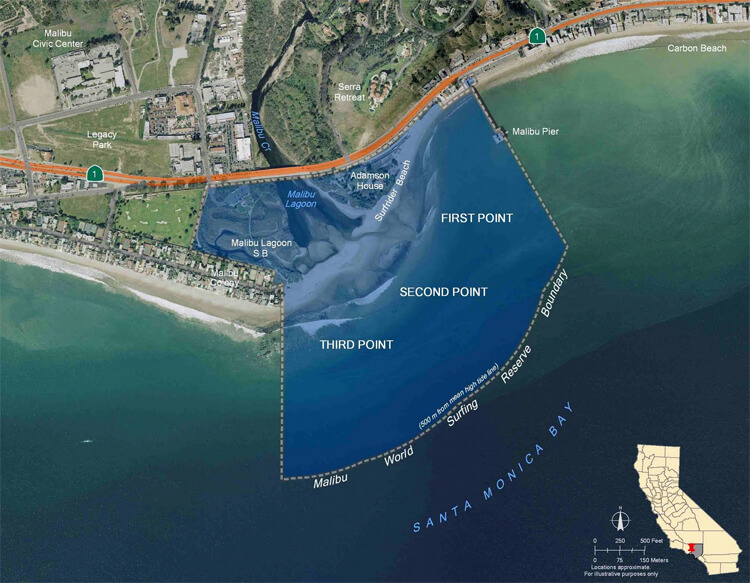
Third Point
The Third Point produces the farthest and biggest wave with both left and right options - it's a high-performance liquid wall.
"On a booming six-foot swell, the sections will link up, and it's possible to ride a wave all the way from Third Point to the pier," notes Sam Bleakley, author of "The Longboard Travel Guide."
"Glassy mornings are guaranteed, with onshores usually kicking in by noon."
Depending on the conditions, you may see two shortboards splitting the peak at Third Point while a longboard shoots the curl at Second Point.
If you're on a logger or funboard, your place is on First Point; if you're out for a surf at Malibu on a shortboard, paddle out at Second Point or Third Point.
Shooting the Pier
In late summer, surfers often find golden opportunities to shoot the pier, courtesy of regular south swells.
However, shooting the pier is always a dangerous stunt.
On June 5, 1951, African American surfing pioneer Nick Gabaldón lost his life while trying to shoot the Malibu pier. And he wasn't the last one.
The best time of the year to surf Malibu Surfrider Beach is August and September when Pacific Ocean storms produce quality groundswells.
On average, the waves at Malibu range from two to four feet, but during summer and autumn swells, you may find eight-foot waves peeling steadily across the line.
"Getting out to the break at low tide can be painful on the feet because there are small rocks and boulders everywhere along the shore - and urchins from Second Point to Third Point," underlines Raul Guisado and Jeff Klaas, authors of "Surfing California."
Nevertheless, even idyllic surf spots have downsides.
After heavy rains, runoff discharges at the Malibu Lagoon result in beach closures due to dangerous pollution levels.
Surfrider Beach was officially dedicated as the first World Surfing Reserve on October 9, 2010.
Tom Morey, the prolific surfer, and inventor of the bodyboard, once said that "Malibu is the best and easiest wave to surf in the continental US during the summer. Period."
Morey couldn't have said it any better.
Malibu Surfrider Beach, Los Angeles, CA | ID and X-Ray
Location: Los Angeles, California
Type of Wave: Point Break
Best Swell Direction: S-SW-W
Best Wave Size: Ankle-to-Overhead (2-8 feet)
Best Wind Direction: N-NE
Best Tide: Medium
Best Time to Surf: Late Summer and Fall
Best Board: Longboard, Funboard, Shortboard
Skill Level: Intermediate, Advanced
Crowd: Always
Water Quality: Average/Poor
Hazards: Crowd, Pollution
Bottom: Sand
Water Temperature: 55-65 °F (12-18 °C)
Getting There: Car
Nearby Surf Shops: Drill Surf & Skate, Becker Surfboards, Rip Curl Malibu, Catch Surf Malibu Store, Surfing Cowboys, Traveler Surf Club & Coastal Outpost, Malibu Surf Shack, and Zuma Jay's
